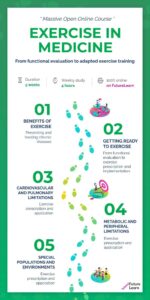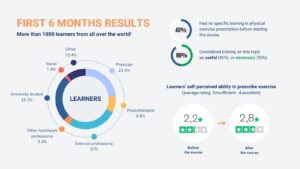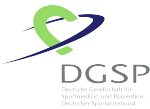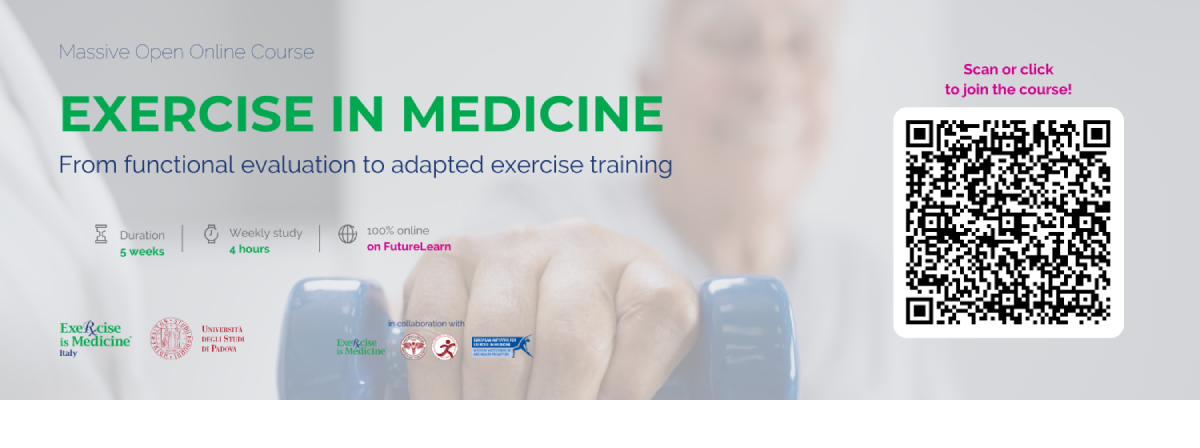Körperliche Aktivität in der Medizin: Von der funktionellen Analyse zur angepassten Trainingstherapie
Editorial der Ausgabe 6/2023 der Deutschen Zeitschrift für Sportmedizin (engl.). Eine Forschungsgruppe aus Italien hat einen Massive Open Online Course entwickelt, der sich mit der funktionellen Bewertung, Verschreibung und Anwendung von individuell angepassten körperlichen Übungen in der Medizin befasst. Der (kostenlose) Kurs wendet sich an ärztliche Praktiker, um deren Kenntnisse zur Verschreibung von körperlicher Aktivität zu verbessern. Sehr empfehlenswert!
Physical activity and exercise are real preventive and therapeutic strategies for most chronic and non-communicable diseases (5). While this evidence is supported by the scientific community and growing literature, data relating to the level of physical activity of people show a significant drop in recent years (3).
It can therefore be stated that physical inactivity is a real pandemic with considerable effects on global health; for this reason “getting people moving” has become a strategic priority also for the World Health Organization (1). It seems reasonable that a joint effort by policy makers and the medical community is required to achieve this important goal (4,6). Scientific evidence and international guidelines have never been more consistent in recommending the “exercise pill” for a wide variety of chronic diseases, highlighting the need to adapt the prescription to the subject’s conditions (just like with drug prescriptions). But is physical exercise really prescribed in healthcare? Are doctors trained to prescribe exercise? Do exercise professionals have specific skills in adapting exercise for patients with chronic conditions?
Bridging the Cultural Gap on Exercise Prescription in Medicine
Currently available data suggest that the prescription of structured and individualized physical exercise is still very rare among physicians and that there is an important cultural gap in the training of both physicians and exercise/healthcare professionals (2). An effective implementation is further complicated by the lack of an extensive territorial network of facilities suitable for the application of physical exercise programms as medical treatment of the main chronic and non-communicable diseases.
Starting from these assumptions, our research group proposed a Massive Open Online Course (MOOC) dedicated to the functional evaluation, prescription and application of individually adapted physical exercise in medicine. This particular course modality provides specific interactive and innovative higher education strategies trying to bridge the gap from clinical settings to the gyms. This MOOC, entitled “Exercise in Medicine: From Functional Evaluation to Adapted Exercise Training”, is provided by the Sports and Exercise Medicine Division of the Department of Medicine of the University of Padova (Italy) as an open-access educational resource for a global audience.
The communication and course contents are suitable both for “healthcare professionals” and for educated people interested in the subject, but without specific training. The terminology used is technical, but accompanied by an explanatory glossary. An active learning approach with innovative technologies, many clinical cases and practical insights into clinical exercise prescription/application are provided. These teaching techniques are designed to convey a problem-based learning in the most effective way, also facilitating an interaction with professionals and learners from all over the world. The e-learning platform Future Learn enables the exchange of ideas and discussions provided by high-level international experts and moderated by trained educators. Furthermore, this interactive MOOC may also facilitate the development of a network within international initiatives working on Exercise in Medicine.
The course starts from the assessment of the physical activity level as a vital sign and goes throughout to the functional evaluation process. Particular attention is given to cardiopulmonary exercise testing, the gold standard assessment for cardiorespiratory fitness and efficiency, which also allows to identify the underlying functional limitations in the oxygen transport system during exercise. Based on this test, exercise prescription can be more precisely individualized in order to overcome the individual functional limitations and ensure a safe and effective training program. However, the exercise prescription cannot be effective if not conveyed to the patient with appropriate communication. The course therefore includes insights into a specific method of counselling for those who must start or continue a training program. The various barriers that the patient may encounter in this process are addressed and some useful ideas are provided to overcome them. Furthermore, the topic “Exercise in Medicine” is also analysed with an implementation lens focusing on various settings of society and the healthcare system. A summary overview of the course is shown below and its interactive version is available at https://view.genial.ly/637f8df025d1600011c4c092.

https://view.genial.ly/637f8df025d1600011c4c092), by clicking on the headlines of each week, you can view the summary of each week‘s thematic content.
Course Overview
The final aim of the MOOC “Exercise in Medicine: From Functional Evaluation to Adapted Exercise Training” is to learn how to use functional evaluation for adapted exercise prescription and how to implement exercise as medical treatment into healthcare systems.
This educational project has been dynamically supported by many high-level international experts in this specific field, providing an added value for this course. The course addresses many different physiological (such as exercise in childhood, pregnancy and the elderly) and pathological conditions, providing suggestions and strategies to bypass the underlying functional limitation with adapted exercise prescriptions for:
– cardiovascular, respiratory, metabolic, neurological diseases;
– patients with cancer, post solid organ transplantation, children and adults with congenital heart disease or other functional disabilities;
– subjects during different stages of life and with mental health disorders.
Based on the course’s learning objectives, participants will be able to:
– Explain the benefits of physical exercise for the prevention and treatment of specific chronic conditions.
– Interpret an evaluation of the patient’s level of physical activity, exercise capacity and cardiorespiratory fitness.
– Describe and articulate an individualised exercise prescription/programme, also addressing patient’s compliance, related barriers, and the environment, from higher altitudes of the mountains to the depth of the seas, considering the impact of ambient temperature as well.
Participants’ Learning Experience
Such open educational resources can contribute to the enormous training needs that exist in the area of exercise medicine. Although the “exercise pill” is a class I recommendation, level of evidence A, for many health conditions, the existing cultural gap make it still seem a relatively new topic. Furthermore, the specific training is very heterogeneous and often lacking in healthcare all over the world. This is supported by what has been expressed by the learners who have attended the course so far and who have decided to express their opinion on the matter.
The first consideration is that in just a few months more than thousand learners from all over the world have registered for this innovative online course. This underlines the need for training in this area. The figure below shows an overview of the course participants and their satisfaction regarding the MOOC.
Many of the learners are physicians (23%) or exercise professionals (27%), who have decided to further improve their specific knowledge in adapted exercise therapy because they feel not adequately trained to apply it in their clinical practice. 40% states to not have had a specific training regarding exercise prescription. Moreover, the pre-course survey shows that more than 50% of the participants consider training on this topic to be necessary and other 40% as useful.
99% of the participants found their expectations fulfilled and of these, half states that the course is even better than they expected. 97% of the participants specifies that gained new knowledge and skills by attending the course and 79% shared what they have learned with others. These statements emphasize how an accessible, direct, concise and goal-focused training mode enables people to really learn and disseminate their knowledge. The feedback also confirms that in addition to the interest in the matter, the course design and communication mode are effective and well accepted. In support of this, we positively note that participants’ self-perception of their own ability to prescribe exercise, assessed on a scale of 1-4 (1 is insufficient and 4 is excellent), rose from an average of 2.2 to an average of 2.8 during the course; less “insufficient” responses and more “good” and “excellent” self-evaluations have been registered in the final follow-up survey. Futhermore, 98% of people agree that their skills and knowledge are improved after the course.
Conclusions and Perspectives
In light of these data, it can be concluded that training on functional assessment and exercise prescription is still lacking worldwide. Simultaneously, many healthcare and exercise professionals feel the need to receive training on this topic and recognise this ability-gap as the first barrier in prescribing and applying exercise in daily practice. Furthermore, the MOOC’s communication and autonomous learner-centred training modalities seem to adequately respond to the needs of interested professionals and facilitate the achievement of the learning objectives, reaching high user satisfaction ratings. If the challenge for the future is to design a more physically active and thus healthier world, one of the first steps must be the dissemination of educational contents and initiatives between healthcare- and exercise-professionals as well as the population. For all these solid reasons, the teaching of individualised exercise prescription should be a shared goal of policymakers and all major institutions of higher education in medicine. All health professionals should have at least basic knowledge and skills about individualised exercise prescription/application; within the general population the principles and benefits of a physically active living and healthy lifestyle should be disseminated. In this way, everyone will be able to contribute, in his or her own setting, to build a more active and thus healthier world.

Acknowledgements
The MOOC Working Group (Prof. Andrea Ermolao MD; Veronica Baioccato MD; Anna Centanini MD; Sara Ortolan MD). International experts contributing in the MOOC (Paolo Emilio Adami; Gerardo Bosco; Davide Brotto; Stefan-Sebastian Busnatu; Martina Celidoni; Silvia Cerea; Véronique Cornelissen; Rebecca Gould; Dominique Hansen; Alberto Maran; Tatiana Moro; Marco Narici; Robert Newton; Josef Niebauer; Jean Michel Oppert; Mark Stoutenberg; Willem Van Mechelen; Maurizio Varnier; Nicola Vitturi; Johannes Zwerver).
■ Battista F, Sarri C, Foccardi G, Quinto G, Faggian S, Vecchiato M, Duregon F, Neunhaeuserer D
Ähnliche Beiträge zum Thema finden Sie weiter unten!
Quellen:
Dempsey PC, Friedenreich CM, Leitzmann MF, Buman MP, Lambert E, Willumsen J, Bull F. Global Public Health Guidelines on Physical Activity and Sedentary Behavior for People Living With Chronic Conditions: A Call to Action. J Phys Act Health. 2021; 18: 76-85. doi:10.1123/jpah.2020-0525
Foccardi G, Hansen D, Quinto G, Favero C, Coninx K, Ruiz GR, Dendale P, Niebauer J, Ermo-lao A, Neunhaeuserer D. How do General Practitioners assess physical activity and prescribe ex-ercise in patients with different cardiovascular diseases? An Italian pilot study. Eur J Prev Car-diol. 2021; 28: e20-e24. doi:10.1177/2047487320925221
Guthold R, Stevens GA, Riley LM, Bull FC. Worldwide trends in insufficient physical activity from 2001 to 2016: a pooled analysis of 358 population-based surveys with 1·9 million partici-pants. Lancet Glob Health. 2018; 6: e1077-e1086. doi:10.1016/S2214-109X(18)30357-7
Neunhaeuserer D, Niebauer J, Degano G, Baioccato V, Borjesson M, Casasco M, Bachl N, Christodoulou N, Steinacker JM, Papadopoulou T, Pigozzi F, Ermolao A. Sports and exercise medicine in Europe and the advances in the last decade. Br J Sports Med. 2021; 55: 1122-1124. doi:10.1136/bjsports-2021-103983
Pedersen BK, Saltin B. Exercise as medicine – evidence for prescribing exercise as therapy in 26 different chronic diseases. Scand J Med Sci Sports. 2015; 25: 1-72. doi:10.1111/sms.12581
Steinacker JM, van Mechelen W, Bloch W, Börjesson M, Casasco M, Wolfarth B, Knoke C, Pa-padopoulou T, Wendt J, Al Tunaiji H, Andresen D, Andrieieva O, Bachl N, Badtieva V, Beucher FJ, Blauwet CA, Casajus Ma**llen JA, Chang JH, Clénin G, Constantini N, Constantinou D, Di Luigi L, Declercq L, Doutreleau S, Drozdovska S, Duclos M, Ermolao A, Fischbach T, Fischer AN, Fossati C, Franchella J, Fulcher M, Galle JC, Gerloff C, Georgiades E, Gojanovic B, González Gross M, Grote A, Halle M, Hauner H, Herring MP, Hiura M, Holze K, Huber G, Hughes D, Hutchinson MR, Ionescu A, Janse van Rensburg DC, Jegier A, Jones N, Kappert-Gonther K, Kellerer M, Kimura Y, Kiopa A, Kladny B, Koch G, Kolle E, Kolt G, Koutedakis Y, Kress S, Kriemler S, Kröger J, Kuhn C, Laszlo R, Lehnert R, Lhuissier FJ, Lüdtke K, Makita S, Manonelles Marqueta P, März W, Micallef-Stafrace K, Miller M, Moore M, Müller E, Neunhäuserer D, Onur IR, Ööpik V, Perl M, Philippou A, Predel HG, Racinais S, Raslanas A, Reer R, Reinhardt K, Reinsberger C, Rozenstoka S, Sallis R, Sardinha LB, Scherer M, Schipper-ijn J, Seil R, Tan B, Schmidt-Trucksäss A, Schumacher N, Schwaab B, Schwirtz A, Suzuki M, Swart J, Tiesler R, Tippelt U, Tillet E, Thornton J, Ulkar B, Unt E, Verhagen E, Weikert T, Vet-tor R, Zeng S, Budgett R, Engebretsen L, Erdener U, Pigozzi F, Pitsiladis YP. Global Alliance for the Promotion of Physical Activity: the Hamburg Declaration. BMJ Open Sport Exerc Med. 2023; 9: e001626. doi:10.1136/bmjsem-2023-001626




